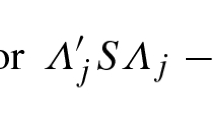Abstract
Lawley's selection theorem is applied to subpopulations derived from a parent in which the classical factor model holds for a specified set of variables. The results show that there exists an invariant factor pattern matrix that describes the regression of observed on factor variables in every subpopulation derivable by selection from the parent, given that selection does not occur directly on the observable variables and does not reduce the rank of the system. However, such a factor pattern matrix is not unique, which in turn implies that if a simple structure factor pattern matrix can be satisfactorily determined in one such subpopulation the same simple structure can be found in any subpopulation derivable by selection. The implications of these results for “parallel proportional profiles” and “factor matching” techniques are discussed.
Similar content being viewed by others
References
Ahmavaraa, Y. The mathematical theory of factorial invariance under selection.Psychometrika, 1954,19, 27–38.
Aitken, A. C. Note on selection from a multivariate normal population.Proc. Edinburgh Math. Soc., 1934,4, 106–110.
Barlow, J. A. and Burt, C. The identification of factors from different experiments.Brit. J. statist. Psychol., 1954,7, 52–56.
Birnbaum, Z. W., Paulson, E., and Andrews, F. C. On the effects of selection performed on some coordinates of a multi-dimensional population.Psychometrika, 1950,15, 191–204.
Cattell, R. B. “Parallel proportional profiles” and other principles for determining the choice of factors by rotation.Psychometrika, 1944,9, 267–283.
Cattell, R. B. and Cattell, A. K. S. Factor solutions for proportional profiles: Analytical solution and an example.Brit. J. statist. Psychol., 1955,8, 83–92.
Harman, H.Modern factor analysis. Chicago: Univ. Chicago Press, 1960.
Horst, P. Relations betweenm sets of variates.Psychometrika, 1961,26, 129–150.
Lawley, D. N. A note on Karl Pearson's selection formulae.Proc. roy. Soc. Edinburgh (Section A), 1943–44,62, 28–30.
Thomson, G. H. and Ledermann, W. The influence of multivariate selection on the factorial analysis of ability.Brit. J. Psychol., 1939,29, 288–305.
Thurstone, L. L.Multiple-factor analysis. Chicago: Univ. Chicago Press, 1947.
Wrigley, C. and Neuhaus, J. The matching of two sets of factors. Contract Memorandum Report, A-32, Univ. Illinois, 1955.
Author information
Authors and Affiliations
Rights and permissions
About this article
Cite this article
Meredith, W. Notes on factorial invariance. Psychometrika 29, 177–185 (1964). https://doi.org/10.1007/BF02289699
Received:
Revised:
Published:
Issue Date:
DOI: https://doi.org/10.1007/BF02289699




